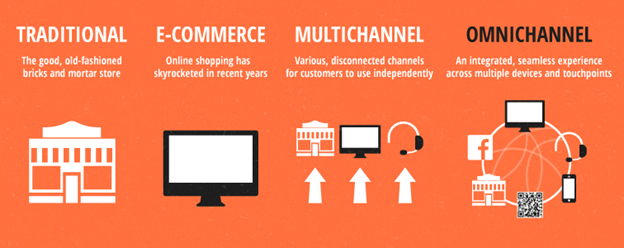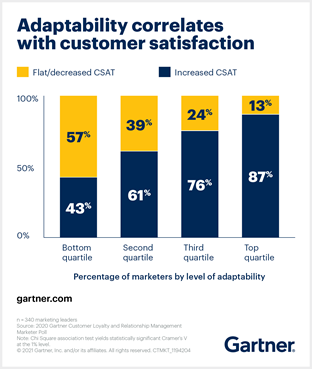“We see our customers as invited guests to a party, and we are the hosts. It’s our job every day to make every important aspect of the customer experience a little bit better.” – Jeff Bezos
Customer satisfaction is affected by all brand touchpoints, from first impressions to customer service, and impacts customer loyalty. And today, meeting the bare minimum customer service expectations will not make the cut.
A slightly satisfied customer may be easily influenced by your competitors. To encourage loyalty, you’ll need to align your products or services with the customer’s wants, needs, pain points, and dreams.
Loyal customers don’t just return to you; they also spread the word about you and encourage friends and family to purchase from you.
In this age of social media where every branded grievance can be broadcast online, can you really afford to ignore customer satisfaction?
Why is customer satisfaction important?
80% of companies use customer satisfaction (CSAT) scores to analyze customer experience and improve it.
High customer satisfaction gives you the following benefits:
- Increase in revenue
- Increase in brand loyalty: lower churn rate and higher retention
- Less negative word of mouth
- Better brand buzz: more positive reviews and more social media chatter
- Competitive advantage
Let’s see how you can work towards improving customer satisfaction and ensuring that customers are generally pleased to do business with you.
5 actionable tips to increase customer satisfaction
Here are five tips you can use to meet the needs of your customers and address their pain points:
1. Enable self-service
90% of consumers expect companies to offer a self-service application on their website. When people feel empowered to help themselves, they rate the company’s products or services higher.
Self-service enables customers to seek online support without directly interacting with a customer service representative (CSR). The most common types of self-service formats are FAQs, videos, how-to guides, diagrams, articles, and online discussion forums.
A good self-service portal should have the following elements:
- A knowledge bank
- Password reset option
- Option to log a service request
- Community forums for customers to share tips and information
Creating a professional website with a self-service portal is no longer challenging or expensive. High-quality drag and drop website builders are available that enable you to create, design, and manage a website without the need for advanced technical skills.
Remember to optimize the self-service portal for mobile users since mobile devices account for 54.8% of the global website traffic. Google’s mobile-first indexing has also made mobile-friendliness a ranking signal, so if you want more people to use your self-service portal, you need to prioritize mobile users in your website design.
2. Provide omnichannel support
The easier you make it for customers to reach you, the higher their satisfaction levels become. Omnichannel support makes the customer experience seamless by connecting experiences across channels.

Customer data is held at a central location so that CSRs can quickly access it across touchpoints and channels through a single dashboard view. CSRs can share context and notes about a customer’s previous interactions and actions so the customer does not have to repeat their concerns.
Thus, you can provide consistent customer support irrespective of the channel through which customers contact you.
Consider establishing a support presence on a variety of channels like:
- Phone
- Live chat
- Social media
- SMS
- Self-service
By engaging with customers through their preferred channels, you’re indicating that you value their preferences. It increases the credibility of your brand and enhances customer satisfaction.
3. Measure customer satisfaction scores
Customer satisfaction measures consumers’ perceptions of whether a product or service meets their needs and expectations.
CSAT is mostly used to measure the satisfaction level of a specific aspect of customer service such as the channel used or the CSR interacted with.
CSAT feedback is captured in post-transaction surveys or voice of the customer (VoC) methods like recorded call data, live chat, social media, email, or website behavior.
90% of marketing leaders agree that marketing teams should be more adaptive to shifting customer needs, but 66% of leaders say that they struggle to meet customer demands.
In the same survey, more adaptable marketing functions were found to have greater CSAT scores.

Conduct customer satisfaction surveys through a CX management platform. Ask customers to rate their satisfaction on a linear scale of 1-3, 1-5, 1-7, or 1-10.
The CSAT score is calculated by adding all the ratings and dividing the sum by the number of respondents.
CX management tools enable you to segment respondents by categories, allowing you to take action based on the category.
- If a category of customers is dissatisfied, you can dig deeper to find out why and make improvements.
- If a group of customers is highly satisfied, you can plan advocacy programs to get more value out of the group.
4. Turn negative feedback into positives
Don’t be afraid of negative feedback — it provides valuable insight into what is not working and what needs to be fixed.
Your focus should be on managing your online reputation by resolving the problem and dealing with the customer politely.
A few tips on turning negative reviews into positive ones:
- Separate constructive criticism from destructive feedback or rants. Use constructive feedback to inform your business strategy and customer support programs.
- Put a system in place to address negative reviews if they are justified. Be courteous, address the problem, offer to remedy it, and provide relevant contact information. Most dissatisfied customers will appreciate your gesture.
- Identify the exact problem by asking open-ended questions.
- Once you have fixed the issue, let your customers know that you have taken their feedback seriously.
- Offer something of value to dissatisfied customers such as a discount voucher. It shows that you’re trying to make amends for the inconvenience caused.
5. Go the extra mile
Delight your customers by doing something special for them.
Surprise them with handwritten notes and holiday cards, send birthday or anniversary gifts, or offer a sneak-peek into new products and services.
Reward loyal customers with an extra special experience that is suitable to their tastes. Loyalty programs with a high degree of personalization are popular because it allows companies to collect customer data.
An analysis of your customer base will tell you which strategies will work best.
Wrapping up
Creating memorable experiences is the key to getting customers to trust you and continually buy from you. Focus on personalization and customer delight, and be prompt in responding to customers’ concerns.
Your customers will appreciate your efforts at improving your offerings and your business will grow with continuous, constructive communication.


